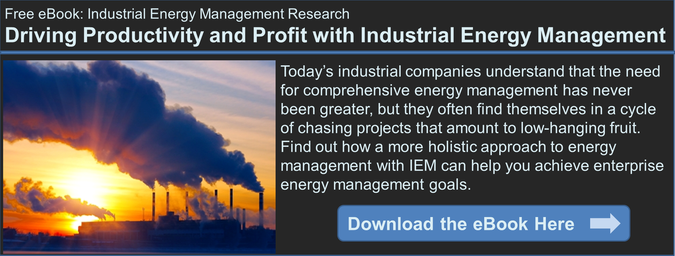 Today, industrial manufacturing companies are facing greater operational and regulatory burdens than ever before. And while most companies have a strong annual focus on growing financially, the new realities of the business climate have made many organizations see that growth can only occur if operations are efficient and harmonized with sustainability initiatives. This is where Industrial Energy Management (IEM) can and does play a big role in helping to see and handle the larger overall energy picture.
Today, industrial manufacturing companies are facing greater operational and regulatory burdens than ever before. And while most companies have a strong annual focus on growing financially, the new realities of the business climate have made many organizations see that growth can only occur if operations are efficient and harmonized with sustainability initiatives. This is where Industrial Energy Management (IEM) can and does play a big role in helping to see and handle the larger overall energy picture.
In this post, we'll discuss the challenges that today's manufacturers are facing around energy and how IEM solutions are helping them drive more value.
The Challenges of Informational and Technological Silos
 According to the LNS Research IEM survey, completed by over 200 industrial companies to date across a range of industries, many have considerable challenges around both obtaining accurate and timely energy metrics (39% of respondents) and also in dealing with disparate systems and data sources (31%). Both of these challenges stem in part from a disjointed approach to energy management--from purpose-built and legacy solutions, a lack of collaboration across key stakeholders and departments in the value chain.
According to the LNS Research IEM survey, completed by over 200 industrial companies to date across a range of industries, many have considerable challenges around both obtaining accurate and timely energy metrics (39% of respondents) and also in dealing with disparate systems and data sources (31%). Both of these challenges stem in part from a disjointed approach to energy management--from purpose-built and legacy solutions, a lack of collaboration across key stakeholders and departments in the value chain.
In this failure to fully connect the goals of leadership all the way down to the shop floor in laying the appropriate cultural roots supported by processes and technology, what's common is for many companies to become stuck in a perpetual cycle of pursuing "low hanging fruit" initiatives around areas such as lighting, compressed air, HVAC, and others and not tackling the bigger, more systemic issues relevant to the production process or energy-intensive production assets.
Piecing Key Information Together with IEM
There are many key functions of IEM software that help manufacturers extend their efforts beyond the low hanging fruit. The following three are important in doing so.
Improved Data Collection
Strong data management capabilities are a key pillar of IEM software solutions. IEM provides the technology for collecting and contextualizing data from both the shop and top floors by integrating data sources from the machine level all the way to the enterprise systems.
At the enterprise level in particular, data acquisition requires the ability to manage both meter usage data and financial data. Moreover, additional abilities are needed to balance this against actual shop floor data. IEM software is key in delivering these strong integration capabilities.
More Comprehensive Monitoring
Before beginning on any energy management initiative, it's important to first have accurate baseline energy information to understand if and when real progress is being made. IEM software is a tool that enables visualization and tracking capabilities to support this. At the enterprise level, monitoring solutions need to have the capability to distill information by role, by event, through the Web, and via mobile solutions. Having the right dashboards and operational alerts in front of the right decision makers at the right time is critical in better informing decisions and accelerating the speed at which they are made.
Efficiency and Operational Effects
For industrial companies, attaining greater efficiency is generally where ROI is achieved and corporate sustainability goals are hit. Production processes can be incredibly complex, encompassing several stages and multiple variables, all of which have effects on yields and productivity. Unfortunately, energy is not always connected to production goals. IEM can be a valuable tool in forging this connection through data analysis and visibility. In this way, with this level of visibility, operations accurately quantify the relationship between energy and production, and begin to treat energy expenditures almost as a raw material with respect to production and in predictive maintenance rather than just as an overhead or facility cost.
Improvements in Energy KPIs
So how is IEM software translating to measurable results today for adopting companies? Drawing back to the earlier-mentioned survey, according to respondents it was revealed that, when comparing companies that had implemented IEM software vs. those that hadn't:
- Companies that had automated data collection at the production asset level enjoyed a 10% reduction of median energy intensity vs. 5% for those who hadn't
- Companies that have implemented the ability to monitor and respond in real-time to operational energy consumption at the asset level reported a 8% reduction of median energy intensity vs. 5% for those who hadn't
Understanding the Energy Management Framework for Sustained Success
Above we illustrated the key visibility and analytics tools that are proving so useful and important in helping companies better monitor and make more informed decisions about their energy usage. But energy use is only part of the equation, to optimize energy management, we need to have the foundation of properly aligned cross-functional teams operating on a foundation of sound and effective processes that span use and energy procurement. To learn more about maximizing productivity and energy efficiency by also connecting to procurment processes, click below for a free download of our eBook on the subject, "Driving Productivity and Profit with Industrial Energy Management."
